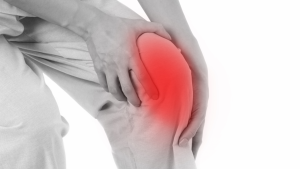Degenerative adult scoliosis, also known as adult-onset scoliosis, is when the facet joints and intervertebral discs deteriorate and lead to a curve in the spine. This side-to-side curve occurs over time as a person gets older. It commonly begins after age 40, and is more frequently seen in patients who suffer from osteoporosis. Osteoporosis causes the bones to lose bone density, quickening the deterioration rate. The spine can begin to “lose shape,” and a scoliotic curve can develop.

What is Degenerative Scoliosis?
Causes of Degenerative Scoliosis
Age is the leading cause of degenerative scoliosis. Over time, facet joints and discs can deteriorate over time, causing the spine to weaken and lose shape. The joints and discs are what make your back flexible. The joints enable bending and twisting. The discs act as shock absorbers.
Degenerative changes are all part of getting older; however, there are other conditions that cause degeneration at high rates:
- Arthritis: Weak joints and irregular vertebral alignment caused by pressure on the spine.
- Osteoporosis: Loss of bone density weakens the bones and their stability.
- Spine Surgery: Recovery and time after a spinal surgery can cause spine deformities.
Aging joints, combined with any of the factors above, can cause significant deformity. Mild-to-moderate deformity is common in older people but can appear in people as young as their 40s. Studies show that approximately 60% of people over the age of 60 have mild degenerative scoliosis.
Treatments
Degenerative adult scoliosis can cause pressure on the nerves and along the spinal cord. This leads to weakness, numbness, and pain in your lower extremities. In extreme cases, the pain and weakness can make walking difficult.
Unlike scoliosis in adolescents, treatments for spine deformity in adults is determined by the severity of the symptoms, not the severity of the curve of the spine. Treatments tend to focus on managing the pain and reducing symptoms as opposed to correcting the curve.
For mild-to-moderate cases, treatment usually consists of pain management and physical therapy (PT). PT is used to increase mobility of the spine. Low-impact exercises may be used to help restore strength of the spine, with hopes of decreasing the symptoms and rate of deterioration. Over-the-counter medications can be used to manage and reduce pain. NSAIDs help minimize pain caused by inflamed joints or arthritis. Medications are not used to heal the spine, but to reduce pain caused by the curvature of the spine. Reducing pain can allow a patient to resume normal daily activities while they work to regain strength and flexibility.
Other ways to treat degenerative adult scoliosis include:
- Weight Loss: Losing weight helps decrease the pressure placed on facet joints
- Nutrition: Eating foods that help reduce anti-inflammatory properties – such as tumeric and ginger – help reduce the pain. Drinking water is important
- Bracing: A brace is used to restrict motion to relieve pain during daily activities and perhaps during physical therapy. Braces can also be used to decrease stress on the facet joints.
If the symptoms and curvature of the spine is severe, your doctor may recommend surgical options. Surgery is used when the patient’s pain is so severe that is become debilitating or when there is nerve damage from the spine curving. Nerve damage can result in the loss of normal bodily functions such as walking or bladder control.
To learn more about degenerative adult scoliosis, contact the team of experts at Progressive Pain Management. Fill out the form below to get in touch today.
Like the rest of your body, your bones need nutrients to thrive. A healthy diet is crucial to maintaining your overall health and the well-being of your bones.
An important way of maintaining proper bone health and preventing bone diseases like osteoporosis is by focusing on proper nutrition. Diets rich in calcium, vitamin D, iron, and other micronutrients greatly prevent osteoporosis.

Cooking a Healthy Diet for Osteoporosis
Eating a well-balanced diet can provide your body with the nutrients it needs. Here are a few ways to incorporate healthier food options into your daily diet.
Nutrition and Osteoporosis
-
Eating Fruits, Veggies, and Whole Grains
Eating foods that are low in calories and fat, but high in fiber and vitamins can help protect your bones against diseases. Whole grains, fruits, and veggies are high in magnesium, potassium, and vitamin C. It is recommended to eat four servings a day.
-
Limit Processed Foods
Foods that are processed contain harmful additives, like phosphorus. This can interfere with how much calcium is absorbed into your body. Foods high in sugar and salt are also harmful and have been known to offer little nutritious value. A diet high in sugar is highly caloric and little few vitamins. Too much salt can affect your blood pressure and increase calcium excretion.
-
Eat Healthy Fats
To function correctly, your body needs some fat in its diet. Monounsaturated fats – those found in nuts, olive oil, and seeds – is the best choice. Including omega-3 fatty acids that is found in cold water fish provides your body with eicosapentaenoic acid (EPA) and docosahexaenoic acid (DHA) which is important to your body’s overall health.
-
Include More Protein
A major component of your bone tissue is protein. Include plant proteins like beans and nuts for a good source of vitamins, minerals, and plant compounds that help preserve bone density. Protein like milk and yogurt are another good source of protein, and they also include calcium, which is important for your bone health.
-
Reduce Alcohol
Alcohol has been linked to the deterioration of bone and the body’s ability to absorb calcium. If you choose to drink, drink in moderation – meaning one drink a day in adults older than 65 and no more than two drinks a day for men 65 and younger. Because women already have a higher susceptibility to bone disease, drinking more than 2 alcoholic beverages a day can hasten bone loss.
There are clear benefits to having a diet rich in calcium and vitamin D. Other micronutrients that optimize bone health can be achieved by adopting a diet that is high in fruits and vegetables that increase the intake of magnesium, potassium, vitamin C, and vitamin K. Not only will it help strengthen your bones, but will help prevent diseases, damage, and fractures.
Knee pain is a common condition that affects people of all ages. It can be acute or chronic pain, depending on the cause.
Knee pain may be the result of a medical condition or an injury. Minor pain typically responds well to at-home methods of treatments; however, in more serious cases, your physician may recommend interventional procedures.
Causes of Knee Pain

What You Need to Know About Knee Pain?
The causes of knee pain can be divided into three major categories: acute, chronic/overuse, and medical.
Acute knee pain encompasses most injuries such as ligament, meniscal, and broken bones. A direct hit to the bones in the knee can cause the bones to break. Knee fractures are painful and can interfere with the way the knee functions, especially when the kneecap is fractured.
The meniscus, cartilage that acts as the shock absorbers between the bones in the knee, can become injured if twisted while bearing weight.
ACL tears are a common injury to athletes. The ACL is one four ligaments that connects the shinbone to the thigh bone. Injury is often caused by a quick stop and change of direction like in basketball or soccer.
Chronic knee pain, or overuse causes include things like osteoarthritis, tendonitis, and chronic inflammation. Age often contributes to chronic knee pain, as general wear-and-tear on the joints can damage bone and cartilage.
Runners and cyclists often suffer from patellar tendinitis, an inflammation of the tendons which connect the kneecap to the shinbone. It is caused by repetitive motion and by causing stress under the kneecap.
Medical conditions which cause knee pain include gout, autoimmune diseases, and even other mechanical issues. Autoimmune diseases cause inflammation throughout the body, affecting any joint. Gout is a type of arthritis that typically affects the foot, however it can affect other body parts. Flare up can cause severe pain.
When other body parts, such as the foot or hip, are damaged, patients often compensate by walking differently or shifting weight. An altered gait can put more stress on the knee joint.
Treatment Options for Knee Pain
Treatments will vary depending on how severe your pain is and the root cause of your pain.
Medications
In some cases, medication will be prescribed to treat the underlying cause of your pain. These medications are often a form of anti-inflammatory medications to help reduce joint swelling and alleviate pain. If you use over-the-counter medications to regularly treat chronic pain, you should see a physician.
Injections
Joint injections can be used to treat knee pain in certain situations. Corticosteroids reduce arthritis flare-ups and can provide relief for a few months. Platelet-Rich Plasma (PRP) is a concentration of growth factors that helps reduce inflammation and promote healing using the body’s natural abilities.
Physical Therapy
Strengthening muscles that surround the knee can help stabilize the joints, reducing pain. Depending on the condition cause you pain, your physician may recommend physical therapy. Exercises can correct movements that affect your knees and teach good techniques for daily life as well as activities and sports.
Learning to improve flexibility and balance are also important to improving chronic knee pain.
Living with knee pain doesn’t have to prevent you from doing what you love. If you suffer from chronic knee pain, contact the team at Progressive Pain today.

